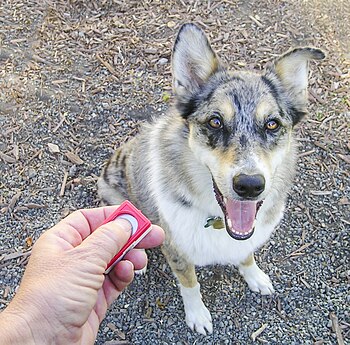The first major improvement in dog training since choke chains and spiked collars, click and treat has quickly establishing itself in becoming a big hit in the world of dog training. Currently, there are over 10,000 trainers who are using this training method everyday.
One advantage to using this form of training at home is it’s easy to learn for both the dog and his trainer!
Originally used to train marine mammals, click and treat breaks down the process into two separate steps, information and motivation. The click is the information, the treat is the motivation. While other trainers still work on these two steps, they try to teach them all at once, which can confuse the animal and slow down results.
 |
| Dog getting clicker training. Tika, the 3-year-old Australian Shepherd rescue agility dog, loves it when the clicker comes out. (Photo credit: Wikipedia) |
Most trainers will verbally praise a dog for good behavior, while at the same time motivating the dog to repeat his actions. This can be a good method, however it takes longer for the dog to understand which behaviors and actions caused the praise from the trainer.
With the click and treat method, the processes are easily taught. In normal training, a person would say “good boy” when a welcomed action occurs and proceed with giving a treat. The clicker becomes a substitute for verbal praise and can actually catch the “good boy” behavior quicker than saying it, letting the dog know exactly which behavior he is being rewarded for.
Another way to look at click and treat training is viewing it as a secondary reinforcement, while food, water, physical affection and play (things the dog wants) become primary reinforcement. When you take a dog for a walk, the leash works as a secondary reinforcement. It is obvious to the dog that the leash is not taking him for a walk; the owner is, however, it triggers a reaction in the dog, telling him that the leash will let him know where he will go and where he will not. And if he reacts to the leash with good behavior, his reward will be a nice leisurely walk.
Click and treat works the same way. When a dog hears the clicker, he will know that he performed a good behavior and as long as he keeps hearing a click, there is a treat coming his way. So, the clicker works as a secondary reinforcement, teaching him boundaries and appropriate behavior.
A couple advantages of the click and treat method include;
1) Faster response than verbal praise. The clicker can identify the exact behavior at the time it happens.
2) It takes the place of treats. While motivating the dog to hear clicks, it will also teach him to work without the expectations of having treats given to him each time he does something good.
3) If the trainer is working at a distance from the dog, the clicker will still work, without having to be right next him.
Are you ready to try clicker training?

The first thing you’ll need to do is go to your favorite pet supply store and invest in a clicker. The clicker is nothing fancy and should just cost you under five dollars. While you’re there grab some pocket treats, little bits of dried liver work well.
A good method to use when getting started with click and treat is to stand in front of the animal. Click the clicker and give a treat. Continue doing this for 20-30 minutes, or until the dog becomes startled by the sound of the click. This will familiarize him to the clicking sound, while teaching him that every time he hears it, he has done something good. After he gets the hang of it, begin by adding commands, such as “sit” and “stay.”
Click and treat has proven to be a simple, yet consistent training method with quick results. So for the trainers out there who are looking for a new and innovative way to motivate and praise their animals, get out there, buy a clicker and... click!




